Related Research Articles

The Drysdale is a New Zealand breed of sheep. It was developed from 1931 by Francis Dry, and derives from sheep of the New Zealand Romney breed in which a mutation caused the coat to be particularly hairy, and thus suitable for carpet-making. It is a specialised carpet wool breed, but also a useful meat breed.
The Damara is a Namibian breed of fat-tailed hair sheep, also found in South Africa. The name derives from that of the Damara region of northern Namibia where it is principally found, particularly in the Kaokoveld Desert. Together with the Namaqua Afrikaner and the Ronderib Afrikaner, it is one of three breeds in the Afrikaner group of sheep that were already in southern Africa before the arrival of colonists, and which forms part of the broader African Long-fat-tailed sheep grouping. It may be solid black, brown or white, or black-and-white pied.

The Suffolk is a British breed of domestic sheep. It originated in the late eighteenth century in the area of Bury St. Edmunds in Suffolk, as a result of cross-breeding when Norfolk Horn ewes were put to improved Southdown rams. It is a polled, black-faced breed, and is raised primarily for its meat. It has been exported to many countries, and is among the most numerous breeds of sheep worldwide.

The Pinzgauer is a breed of domestic cattle from the Pinzgau region of the federal state of Salzburg in Austria. It has distinctive colouring, with chestnut-brown sides and white back and underside. It was in the past a triple-purpose breed, raised for meat, milk and draught use. There is a naturally polled sub-type, the Jochberg Hummel. In 2007 the breed was not considered by the FAO to be at risk.
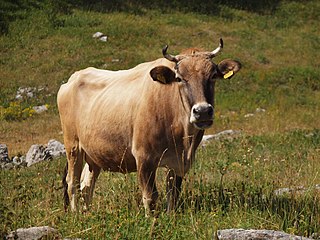
The Buša or Busha is a breed or group of breeds of small short-horned cattle distributed in south-eastern Europe, principally in Albania and the countries of the former Yugoslavia – Bosnia and Herzegovina, Croatia, Kosovo, Macedonia, Montenegro and Serbia. Related breeds include the Gurgucke, Lekbibaj and Prespa of Albania, the Gacko of Bosnia and Herzegovina, the Greek Shorthorn, the Metohija Red of Kosovo and the Rhodope Shorthorn of Bulgaria.

The Pelibüey or Spanish: Cubano Rojo is a Cuban breed of domestic sheep. It is found principally in Cuba, where it is the most numerous breed of sheep, but is also reared elsewhere in the Caribbean and in some coastal parts of Mexico. It is a hair sheep – its coat is of hair, not wool; this is a common adaptation to tropical environments. It is likely that it derives at least in part from African breeds of sheep such as the West African Dwarf, and probable that it is related to other American breeds of African origin such as the Barbados Black Belly, the Roja Africana of Venezuela and the Oveja Africana of Colombia.
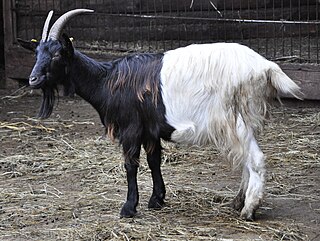
The Valais Blackneck is a breed of domestic goat from the canton of Valais, in southern Switzerland, and neighbouring areas of northern Italy. The largest concentration is in the area of Visp (Viège). It is present in modest numbers in Austria and Germany. It is known by many names, including German: Walliser Schwarzhalsziege or Gletschergeiss; French: Col Noir du Valais, Chèvre des Glaciers or Race de Viège; and Italian: Vallesana or Vallese.
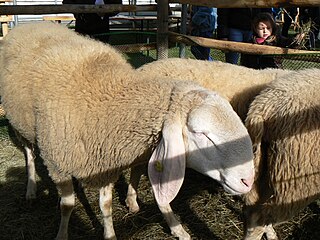
The Bergamasca is a breed of domestic sheep from the mountainous part of the province of Bergamo, in Lombardy in northern Italy. It originates from the area of the Val Brembana and the Val Seriana valleys, and is particularly associated with the plateau of Clusone. By the beginning of the 20th century it had spread through much of Lombardy; it is now raised in most parts of mainland Italy, particularly the province of Teramo in Abruzzo, where more than 80% of the registered stock are kept. The Bergamasca is also present in Brazil, Serbia and Venezuela. It is raised principally for meat, and is often used for cross-breeding with other meat breeds to improve meat yield. In Lombardy, it is traditionally raised by transhumant management: the herds spend the summers on the alpine pasture, and over-winter in the Po valley.

The Devon Longwool was a British breed of domestic sheep from south-west England. It was distributed in southern Somerset and northern Devon, and was – like the Greyface Dartmoor and the South Devon – a polled longwool sheep. It is now considered extinct, as in 1977 it was merged with the South Devon to form the Devon and Cornwall Longwool.
The Azerbaijan, is an Azerbaijani breed or group of breeds of riding horse of Oriental type. In 2007 it was listed by the FAO as endangered; in 2021 it was not among the horse breeds reported to DAD-IS.
The Brentegana is an Italian breed of sheep from the provinces of Trento and Verona in northern Italy. The name derives from that of the comune of Brentonico, the area where the breed is thought to have originated. Two distinct types are known: the Brentegana Scelta or Brentegana Trentina, a large heavy meat/wool type; and the Brentegana Comune, a medium-sized type more suitable for milk production. It is one of the forty-two autochthonous local sheep breeds of limited distribution for which a herdbook is kept by the Associazione Nazionale della Pastorizia, the Italian national association of sheep-breeders.

The Brigasca, French: Brigasque, is a breed of sheep from Liguria in north-west Italy and the département of Alpes-Maritimes in south-eastern France. It takes its name from the town of La Brigue, which was until 1947 in the Italian province of Cuneo. The Brigasca is raised in the provinces of Imperia and Savona in Italy, and neighbouring areas in France. It appears to have origins in common with the Frabosana and Delle Langhe breeds. It is one of the forty-two autochthonous local sheep breeds of limited distribution for which a herdbook is kept by the Associazione Nazionale della Pastorizia, the Italian national association of sheep-breeders.
The Finarda is a breed of large domestic sheep from the regions of Lombardy and Piemonte in northern Italy. It is heavy breed raised mainly for meat, although it also yields 4–6 kg of wool per year. It results from cross-breeding the Bergamasca and Biellese breeds. It is one of the forty-two autochthonous local sheep breeds of limited distribution for which a herdbook is kept by the Associazione Nazionale della Pastorizia, the Italian national association of sheep-breeders. However, in 2008 the herdbook was empty, and may in fact never have been activated. Most data for the breed dates from 1983.
The Istriana or Carsolina, Croatian: 'Istarska Ovca', Slovene: 'Istrska Pramenka', is a breed of domestic sheep from Istria and the Karst regions of the northern Adriatic, from north-east Italy to Croatia and Slovenia.

The Swedish Red-and-White, Swedish: Svensk Röd och Vit Boskap, frequently abbreviated to SRB, is a Swedish breed of dairy cattle. It was created in the 1920s by crossing the Swedish Red Pied and Swedish Ayrshire breeds.
The Swedish Red Pied, Swedish: Rödbrokig Svensk Boskap, frequently abbreviated to RSB, was a Swedish breed of dairy cattle. It is now considered extinct. It was merged in the 1920s with the Swedish Ayrshire breed to create the Swedish Red-and-White, which is one of the principal dairy breeds of Sweden.
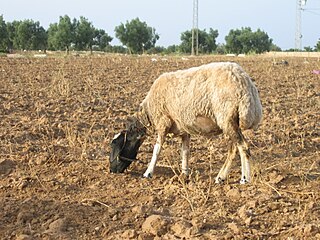
The Tunisian Barbarin is a Tunisian breed of fat-tailed sheep. It is distributed throughout Tunisia, and on both sides of the Tunisian border with Algeria, on the Algerian side particularly in the area of Oued Souf. Related to the Awassi
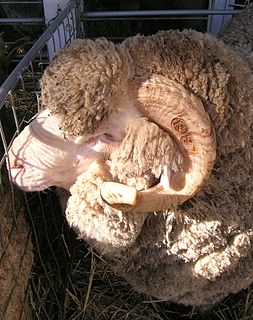
The Australian Merino is an Australian breed or group of breeds of sheep, forming a significant part of the Merino group of breeds. Its origins lie in Merino sheep imported to Australia from South Africa in about 1796. By about 1830 there were almost two million Merinos in the country.
References
- ↑ Valerie Porter, Lawrence Alderson, Stephen J.G. Hall, D. Phillip Sponenberg (2016). Mason's World Encyclopedia of Livestock Breeds and Breeding (sixth edition). Wallingford: CABI. ISBN 9781780647944.
- ↑ Barbara Rischkowsky, Dafydd Pilling (editors) (2007). List of breeds documented in the Global Databank for Animal Genetic Resources, annex to The State of the World's Animal Genetic Resources for Food and Agriculture. Rome: Commission on Genetic Resources for Food and Agriculture, Food and Agriculture Organization of the United Nations. ISBN 9789251057629. Archived 23 June 2020.
- 1 2 3 4 5 6 7 8 9 10 11 12 13 14 15 16 17 18 19 20 21 Breed data sheet: New Zealand, Sheep. Domestic Animal Diversity Information System of the Food and Agriculture Organization of the United Nations. Accessed September 2022.
- 1 2 3 4 5 6 7 8 9 10 11 12 13 14 15 16 17 18 19 20 21 22 23 24 25 26 27 28 29 30 31 32 33 34 35 36 37 38 39 40 41 42 Breed data sheet: Australia, Sheep. Domestic Animal Diversity Information System of the Food and Agriculture Organization of the United Nations. Accessed September 2022.